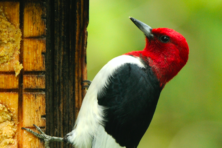Door to Nature: Walkingsticks
- Share
- Tweet
- Pin
- Share

It was a sunny, calm day recently when I noticed a large walkingstick clinging to the outside of my dining room window. It seemed to enjoy basking in the sun. It stayed there all day.
It appeared to be a female. They are larger than males, perhaps to defend themselves. These fascinating insects go through a simple metamorphosis. Adult females live in hardwood forests and, after mating, just drop their eggs to the ground.
When the eggs hatch, the young, called “nymphs,” find shrubs and small trees upon which to feed. They may live like this for quite a while until becoming adults and traveling to larger trees.
In areas where their numbers become very abundant, they can defoliate trees. This can happen to hardwood trees and neighboring shrubs.
The insect’s incredible, stick-like camouflage is mainly to provide protection and not for ambushing other insects. The walkingstick is strictly vegetarian. We found one in our raspberry patch years ago and when Roy gently tapped the raspberry cane, the creature and the plant suddenly became one form.
Once confronted, the walkingstick stretched its front legs straight ahead, causing it to more closely resemble the plant on which it was resting. Young walkingsticks are green and adults tend to be more brownish. Their long thorax and abdomen, lengthy thread-like antennae and long slender legs of about the same length combine to make this insect easy to identify.
Their slow, deliberate motions are similar to the natural wind-caused movements of plants, making the insect and the plant blend all the more. Walkingsticks become very stationary when danger approaches. In fact, they are known to do most of their traveling and feeding under cover of darkness. During daylight hours they tend to rest motionlessly.
This is one of few insects that can regenerate lost legs, usually in the early stage of its life. It is easy to imagine that a creature with such long spindly appendages occasionally loses one to a predator, such as a preying mantis. None of the higher animals on Earth are known to be capable of growing new legs.
The foliage of cherry, oak, hazelnut, locust and walnut trees number among the plant materials that walkingsticks consume. Rarely do damaging outbreaks of these fascinating insects occur in this part of the country. As a matter of fact, they tend to be quite uncommon this far north.
The specimen I enjoyed sitting on my window appeared to be a fully-grown adult. I suspect that mating had already occurred. The female will drop about 100 eggs to the ground as she walks among tree branches and foliage.
A quick-drying, waterproof, varnish-like fluid coats each egg when laid, providing it with a highly protective case. Each oval egg is about three millimeters long and is a polished black with a whitish stripe on the side. The eggs have to be extremely durable because this is the only way walkingsticks at this latitude survive the winter. Hibernation is in the egg stage.
Like grasshoppers and field crickets, walkingsticks go through an incomplete metamorphosis. Nymphs hatch from the eggs and appear like miniature adults. They eat, grow and shed their skin a few times before reaching adult size. From birth to maturity requires about six weeks.
One of the longest insects in the world is an East Indian walkingstick whose body length is around 13 inches. With its legs outstretched it measures 20 inches! I’m aware of only one species of walkingstick in our region and it is considerably shorter than the one from East India.
You might call the walkingstick the “Houdini of the Insect World” – now you see it, now you don’t. This late-summer time of the year wouldn’t be complete without seeing at least one of these marvelous creatures of the insect world.




